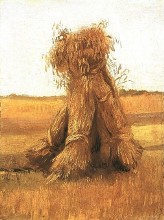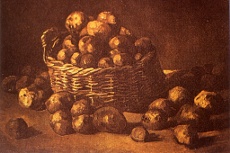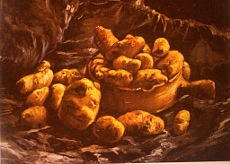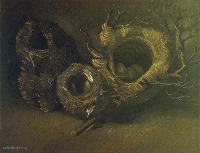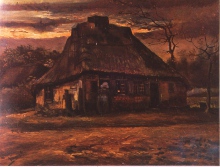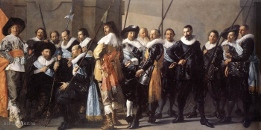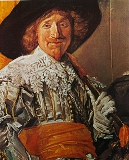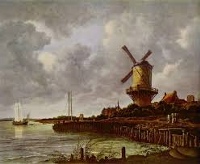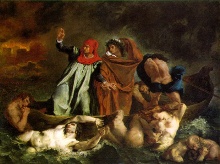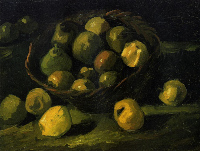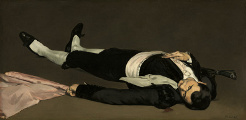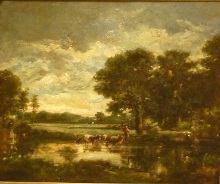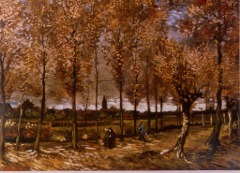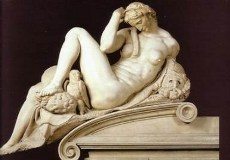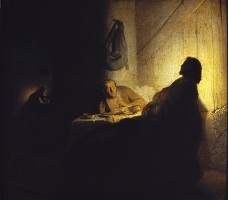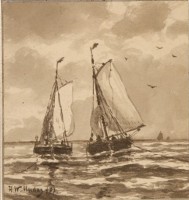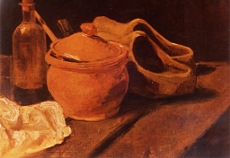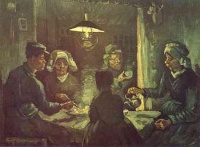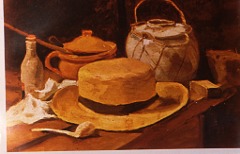A Theory of Colour · 3905 dagen geleden by Ad van den Ende
“His art had greater depth and scope than he ever consciously realized. To a certain extent, indeed, his theories obscured his practice.” (Kurt Bach)
Vicent wrote more eloquently than any other artist about his guiding principles in painting. He was thorougly familiar with the aesthetic preoccupations of the day. Two central concerns of contemporary artists were: “firstly, how does the motif in the picture relate to its original in Nature, and (…) when can a painting be considered “finished”? Secondly: what part does the use of colour play? (…) Experts clung to their academic rules, rating decorative values above the vivid impression of life. (…) Those who opposed the dogmatism of self appointed arbiters of taste necessary became partisans for the sketch, since it was a more direct record of reality.” (Walther&Metzger)
This painting examines the effects various relative yellows have on each other. A colour scheme has taken precedence over the motif.
SEPTEMBER
To Theo van Gogh. Nuenen, on or about Wednesday, 2 September 1885.
My dear Theo,
(…)
When I think about Millet or about Lhermitte — then — I find modern art as great — as Michelangelo and Rembrandt — the old infinite, the new infinite too — the old genius, the new genius. Perhaps someone like Chenavard doesn’t see it like this — but for my part I’m convinced — that in this regard one can believe in the present.
The fact that I have a definite belief as regards art also means that I know what I want to get in my own work, and that I’ll try to get it even if I go under in the attempt. Regards.
Yours truly,
Vincent
To Theo van Gogh. Nuenen, between about Friday, 25 and about Tuesday, 29 September 1885.
My dear Theo,
(…)
What I have for you are some still lifes — of a basket of potatoes — fruit — a copper kettle &c., but which I made specifically in connection with modelling with different colours, and I would like Portier to see them.
I’ll send them to you as soon as I have the money because am at the end of the month.”
OCTOBER
To Theo van Gogh. Nuenen, Sunday, 4 October 1885.
My dear Theo,
(…)
Longing most of all for Rembrandt and Frans Hals, one day this week I’m going to the museum in Amsterdam with a friend of mine in Eindhoven whose studies I once showed you. If I can acquire connections for my own work, I won’t fail to do so — and I firmly believe that with perseverance I’ll win.
As for the work, I’ve been painting a lot of still lifes lately, as I already wrote, and I like it enormously. I’ll send you some. I know that they’re difficult to sell — but it’s devilish useful and I’ll go on doing a lot to them in the winter.
You’ll get a large still life of potatoes — where I’ve tried to get body into it —
I mean express the material. Such that they become lumps that have weight and are solid, which you’d feel if they were thrown at you, for instance.
Anyway, you’ll just have to see.
(…)
I’m now working on still lifes of my birds’ nests, and I’ve finished 4 of them. I think that some people who know nature well might like them because of the colours of the moss, dry leaves and grasses, clay &c.
(…)
Yours truly,
Vincent
I’m sure my work will benefit in the long run if I see more paintings — because when I see a painting I can work out what it’s done with.
As for Poussin— he’s a painter who thinks and makes one think about everything — in whose paintings all reality is at the same time symbolic. In the work of Millet, of Lhermitte, all reality is also symbolic at the same time.
They’re something other than what people call realists.
In the winter, when I have more time for it, I’ll make several drawings of this sort of thing. I feel for the brood and the nests — particularly those human nests, those cottages on the heath and their inhabitants.
To Theo van Gogh. Nuenen, on or about Saturday, 10 October 1885.
“My dear Theo,
I’ve been to Amsterdam this week — I hardly had time to see anything but the museum.
I was there 3 days; went Tuesday, back Thursday. Result is that I’m very glad I went, whatever the cost, and that I don’t propose going for so long again without seeing paintings.
I’d already put it off and put it off, that and so much else, because of the cost. But it’s much better that I can no longer imagine that this is the thing to do. I get too much out of it — for my work, and when I look at the old paintings, which I can decipher as regards technique very differently from before — then perhaps I have precious little need for conversation anyway.
I don’t know whether you remember that to the left of the Night watch, in other words as a pendant to the Syndics, there’s a painting — it was unknown to me until now — by Frans Hals and P. Codde, 20 or so officers full length. Have you noticed it??? In itself, that painting alone makes the trip to Amsterdam well worth while, especially for a colourist. There’s a figure in it, the figure of the standard-bearer in the extreme left corner, right up against the frame. That figure is in grey from top to toe, let’s call it pearl grey, — of a singular neutral tone — probably obtained with orange and blue mixed so that they neutralize each other — by varying this basic colour in itself — by making it a little lighter here, a little darker there, the whole figure is as it were painted with one and the same grey. But the leather shoes are a different material from the leggings, which are different from the folds of the breeches, which are different from the doublet — expressing different materials, very different in colour one from another, still all one family of grey — but wait!
Into that grey he now introduces blue and orange — and some white.
The doublet has satin ribbons of a divine soft blue. Sash and flag orange — a white collar.
Orange, white, blue, as the national colours were then. Orange and blue next to each other, that most glorious spectrum — on a ground of grey judiciously mixed, precisely by uniting just those two, let me call them poles of electricity (in terms of colour, though) so that they obliterate each other, a white against that grey. Further carried through in that painting — other orange spectrums against a different blue, further the most glorious blacks against the most glorious whites — the heads — some twenty — sparkling with spirit and life, and how they’re done! and what colour! the superb appearance of all those fellows, full length. But that orange, white, blue chap in the left corner — — …… I’ve seldom seen a more divinely beautiful figure — — it’s something marvellous.
Delacroix would have adored it — just adored it to the utmost.
I stood there literally rooted to the spot.”
To Theo van Gogh. Nuenen, on or about Tuesday, 13 October 1885.
My dear Theo,
Today I sent — carriage paid — crate V4 with the still lifes.
To my regret, the two little sketches of Amsterdam are quite badly damaged. They got wet on the journey; then the little panels warped when they dried, and dust &c. got into them. I’m sending them all the same to show you that if, in the space of an hour, I want to dash off an impression somewhere, I’m beginning to be able to do this in the same sentiment as others who — analyze — their impressions. And give themselves a reason for what they see. This is something other than feeling, that’s to say undergoing impressions — there may perhaps be a great deal between experiencing impressions and — analyzing them, that’s to say taking them apart and putting them together again. But it’s enjoyable to put something down in a rush.
What particularly struck me when I saw the old Dutch paintings again is that they were usually painted quickly. That these great masters like Hals, Rembrandt, Ruisdael — so many others — as far as possible just put it straight down — and didn’t come back to it so very much.
And — this, too, please — that if it worked, they left it alone.
Above all I admired hands by Rembrandt and Hals — hands that lived, but were not finished in the sense that people want to enforce nowadays. Particular hands in the Syndics even, in the Jewish bride, in Frans Hals.
And heads, too — eyes, nose, mouth done with the first brushstrokes, without any sort of retouching. Unger, Bracquemond etched it well — as it was done, and one can see the manner of painting in their etchings.
Theo, how necessary it is at this time to look at old Dutch paintings now and again! And at the French paintings, Corot, Millet &c. The rest, one can if necessary do without them very well — and upset some people more than they think.
Paint in one go, as far as possible in one go. What a joy it is to see a Frans Hals like that — how very different it is from the paintings — there are so many of them — where everything has been carefully smoothed out in the same way.
I must just come back to certain present-day paintings that are becoming more and more numerous. Some 10, 15 years ago people started to talk about ‘clarity of light’. It’s true that originally this was a good thing; it’s a fact that masterly things came about as a result of that system. But where it increasingly degenerates into an overproduction of paintings where all through the painting — in all 4 corners the same light, the same what I think they call day tone and local colour dominates, is this a good thing??? I think not.
Is the Ruisdael in the Van der Hoop, the one with the mill, not outdoors? Is there no sky in it and vast space? And yet — the whole painting is very much darker than the fellows would do, sky and earth moreover form a single whole, belong together.
Van Goyen — that Corot among the Dutchmen — I stood for a long time in front of that masterly piece in the Dupper Collection, two oaks on a dune in the autumn, in a storm.

Van Goyen Two oaks on a dune in the autumn, in a storm
A sentiment indeed, let me say, like Jules Dupré or like The bush.
But there’s ordinary yellow ochre rather than — white — carried through in the painting. Now the Cuyp — the view of Dordrecht in the Van der Hoop — entirely reddish gold — there again — the ochres.
Frans Hals’s yellow — call it what you will, dull lemon or fawn yellow — what’s it done with? It seems very light in the painting — but just try holding white against it.
A great lesson that the old Dutch masters teach, it seems to me, is this: to regard drawing and colour as one — which Bracquemond says too. That now — many do not do it, they draw with everything except with sound colour. Oh Theo, it’s so awful to listen to, it’s so horribly boring when a chap like Haverman, say, talks about ‘technique’. I don’t say Rappard, because he talks like that too but, fortunately for him, paints better than he talks.
I have absolutely no desire to make a lot of acquaintances among the painting gang. But again — speaking of technique — there’s a great deal sounder and more solid technique in Israëls — for instance in that very old work, the Zandvoort fisherman, with superb chiaroscuro — than the technique of those who are equally smooth and flat all over, and distinguished by their cold, tinny colour.

Israëls The Zandvoort fisherman
The Zandvoort fisherman, well, just go ahead and hang it next to an old Delacroix, The barque of Dante, and it’s the same family. I believe in that, but every day I dislike the paintings that are equally light all over more and more. It’s an unpleasant thing for me when they say that I have ‘no technique’ — it’s possible that this will blow over because I don’t make the acquaintance of any of the painters.
It’s true, on the contrary, that it’s precisely in terms of technique that I find many of the people who prattle on about it the most are weak. I wrote to you about that before. But if I show any of my work in Holland, I know in advance what I have to deal with and with what sort of calibre of technicians.
Meanwhile, I’d rather go very calmly to the old Dutchmen and rather to the paintings by Israëls and those who have a direct affinity with Israëls, which the newer ones do not. They are, rather, diametrically opposed to Israëls. And I think I’ve observed that Israëls himself, Maris, Mauve, Neuhuys himself, view a certain direction we’re now discussing with nothing but displeasure. A Mesdag, for instance, who was once a terrible realist, as you’ll remember — is becoming more tonal in his later paintings and drawings, and often more mysterious. Anyway.
(…)
In the winter I’m going to explore various things regarding manner that I noticed in the old paintings. I saw a great deal that I needed.
But this above all things — what they call — dashing off — you see that’s what the old Dutch painters did famously. That — dashing off — with a few brushstrokes, they won’t hear of it now — but how true the results are. And how masterfully well many French painters, how an Israëls understood precisely that. At the museum — I thought a lot about Delacroix. Why? Because in front of Hals, in front of Rembrandt, in front of Ruisdael and others, I thought constantly of that saying, When Delacroix paints – it’s like the lion devouring his piece of flesh. How true that is — and oh, Theo — when I think about what I’ll call the self-styled technical gang, how deathly it is. Rest assured that if I ever have to do with those gentlemen or come across one of them, I’ll play the innocent — but — à la Vireloque — followed by a cutting remark.
I hate it when things hang fire and go wrong.
And isn’t it something fatal, that forced finishing the same everywhere (what they call finishing!), everywhere that same boring grey light instead of light and shade — local colour, colour instead of tone? Aren’t those deplorable things — and isn’t it so? Anyway — I think these things are wrong because I think Israëls, for instance, so good, because there are so many new and old painters alike whom one can adore.”
To Theo van Gogh. Nuenen, on or about Tuesday, 20 October 1885.
My dear Theo,
I received your letter with the enclosed today. Your letter gave me a great deal of pleasure because I think I discern in it a few things that I’d like to go into in more detail.
Coming straight to the point: what you write about a certain study of a basket of apples — is well observed — but — did you come up with that on your own??? Because I fancy, indeed I’d say know for sure, that you used not to see that sort of thing. Be this as it may — here we are on the way to agreeing more about colours. Now pursue those questions — because that will get you further, and Bürger and Mantz and Silvestre knew that.
Just to say how that study was painted — quite simply this. Green and red are complementary. Well there’s a particular — red in the apples, very coarse in itself — and greenish things as well. Now there are one or two apples in a different colour too — which make the whole thing right — in a particular pink. That pink — is the broken colour, created by mixing the aforementioned red and the aforementioned greenish. There you have the reason why there’s an association between the colours. Added to this is a second contrast — the background forms a contrast to the foreground.
The one is a neutral colour, obtained by breaking blue with orange, the other the same neutral colour, only altered by the addition of some yellow.
But — this gives me immense pleasure, that either by direct or by indirect personal feeling you notice a colour combination. Further — that one of the studies appeared to you to be a variation on the brown-grey theme — that’s very definitely the case — only — all 3 of them are, the ones of the potatoes, with the difference that one is a study in sienna, the other in burnt sienna, the other in — yellow ochre and red ochre.
The latter — that’s the large one — to my mind — is the best — despite the matt black background, which I left matt on purpose because the ochres are also naturally non-transparent colours. As regards this study — the largest one of the potatoes — it was made by altering those non-transparent ochres, by breaking them with a transparent blue.
Red ochre and yellow ochre forming an orange, their combination with blue is more neutral, and they become either redder or yellower against that neutralized colour. The highest light on that whole canvas is quite simply some pure yellow ochre. And the fact that this matt yellow still stands out is because it’s in a wide field of a sort, albeit neutral, of violet; after all — red ochre with a blue gives violet tones.
Well — the nests were also painted on a black background on purpose — for the reason that I simply want it to be obvious in these studies that the objects appear against a conventional background, and are not in their natural setting. A — living nest in nature is — something very different; one hardly sees the nest itself, one sees the birds.
Given that one wants to paint nests from one’s collection of nests, one can’t say emphatically enough that the background and setting in nature are very different — so I made the background — simply black.
(..)
Anyway — Frans Hals is a colourist among the colourists, a colourist like Veronese, like Rubens, like Delacroix, like Velázquez.
Millet, Rembrandt and, for instance, Israëls — it has sometimes rightly been said of them that they are — harmonists rather than colourists.
But — tell me — black and white, may one use them or not? Are they forbidden fruit?
I think not. Frans Hals must have had twenty-seven blacks.
White — but you know yourself what singular paintings some modern colourists purposely made with white on white. What does that phrase mean, one may not?
Delacroix — called them rests, used them as such. You mustn’t be prejudiced against them, because provided they’re in their place and in balance with the rest, one may use all tones — that goes without saying.
(…)
No — black and white, they have their reason and significance, and anyone who suppresses them won’t get it right. The most logical, certainly, is to regard them both as — neutral.
The white the very highest combination of the lightest possible red, blue, yellow — black the very lowest combination of the darkest red, blue and yellow — I have nothing to say against that statement, I think it absolutely true. Well — the light and shade — the tone in terms of value — is directly related to that 4th spectrum from white to black. After all, where one has:
(…)
If I mix yellow with violet to a lilac yellow or yellow lilac, in other words to a neutralized yellow or a neutralized lilac, by adding white and black I get greys.
So. There is primarily a question of greys and browns when one makes colours lighter or darker, whatever their nature and their red, yellow or blue content may be.
To my mind, speaking of light and of dark greys and browns is expressing it correctly.
(…)
Tell me — have you thought that those studies of mine that have black backgrounds have been pitched very low IN THEIR LIGHTS??? And so where I pitch my study lower than in nature I still maintain the relationship between the tones, since I become darker not only in my shadows but also proportionally IN MY LIGHTS TOO? I made my studies specifically as gymnastics, to fall and to rise in tone — so — don’t forget this, that I painted my white and grey moss literally with a mud colour, and that it nonetheless looks light in the study. Adieu, regards.
Yours truly,
Vincent
These things that relate to complementary colours, to simultaneous contrast and to the way complementaries neutralize each other, this question is the first and foremost. The other is — the effect on each other of two similar colours, for example a carmine on a vermilion, a pink lilac on a blue lilac.
The third question is a light blue against the same dark blue, a pink against a brown red, a lemon yellow against fawn yellow, &c. But the first question is the most important.
And if you find some book or other on colour questions that is good, do be sure to send it to me, for I too know far from everything about it, and go on searching every day.
To Theo van Gogh. Nuenen, on or about Wednesday, 28 October 1885.
My dear Theo,
I read your letter about black with great pleasure. And it convinces me accordingly that you aren’t prejudiced against black.
Your description of the Manet study, The dead toreador, was well analyzed. And the whole letter proves to me the same as your croquis of Paris made me think at the time, that if you put your mind to it you can paint something in words.
It’s certain that by studying the laws of colours one can move from an instinctive belief in the great masters to being able to account for why one likes what one likes, and that’s very necessary nowadays when one considers how terribly arbitrarily and superficially people judge.
(…)
Presently my palette is thawing, and the bleakness of the earliest beginnings has gone.
I still often run up against a blank wall when undertaking something, but all the same, the colours follow one another as if of their own accord, and taking a colour as the starting-point I see clearly in my mind’s eye what derives from it, and how one can get life into it.
Jules Dupré is like Delacroix in landscape, for what enormous diversity of mood he expressed in symphonies of colour.
Now a seascape, with the most delicate blue-greens and broken blue, and all sorts of pearly tones.
Then an autumn landscape with foliage from deep wine red to vivid green, from bright orange to dark havana, with yet more colours in the sky in greys, lilacs, blue, white, forming another contrast to the yellow leaves.
Then again a sunset in black, in violet, in fiery red.
Then again more capricious, like the corner of a garden by him that I saw and have never forgotten; black in the shadow, white in the sun, bright green, a fiery red, and then again a dark blue, a bituminous greenish brown and a light brownish yellow. Truly colours that can have quite a lot to say to one another.
I’ve always idolized Jules Dupré, and he’ll become even more recognized than he is now. For he’s a real colourist — always interesting, and with something so powerful and dramatic. Yes, he is indeed a brother to Delacroix.
As I said, I think your letter about black very good, and what you say about not doing it in the local colour is also correct.
Still, it doesn’t satisfy me. To my mind there’s far more behind not doing it in the local colour. True painters are the ones who don’t do it in the local colour — that was what Blanc and Delacroix discussed once.
May I not simply understand by it that a painter does well if he starts from the colours on his palette instead of starting from the colours in nature?
I mean, when one wants to paint a head, say, and one looks closely at the nature one has before one, then one might think, this head is a harmony of reddish brown, violet, yellow, all broken — I’ll put a violet and a yellow and a reddish brown on my palette, and break them into each other.
I retain from nature a certain sequence and a certain correctness of placement of the tones, I study nature so as not to do anything silly, to remain reasonable — but — I don’t really care whether my colours are precisely the same, so long as they look good on my canvas, just as they look good in life.
(…)
A man’s head or a woman’s head, looked at very composedly, is divinely beautiful, isn’t it? Well then — with painfully literal imitation one loses that general effect of looking beautiful against one another that tones have in nature; one preserves it by re-creating it in a colour spectrum PARALLEL to, but not necessarily exactly, or far from the same as the subject.
Always and intelligently making use of the beautiful tones that the paints form of their own accord when one breaks them on the palette, again — starting from one’s palette — from one’s knowledge of the beautiful effect of colours, isn’t the same as copying nature mechanically and slavishly.
Now here’s another example. Suppose I have to paint an autumn landscape, trees with yellow leaves. Very well — if I conceive it as — a symphony in yellow, what does it matter whether or not my basic yellow colour is the same as that of the leaves — it makes little difference. Much, everything comes down to my sense of the infinite variety of tones in the same family.
If you think this a dangerous tendency towards romanticism, a betrayal of ‘realism’ — painting from the imagination — having a greater love for the colourist’s palette than for nature, well then, so be it.
Delacroix, Millet, Corot, Dupré, Daubigny, Breton, 30 more names, do they not form the heart of this century where art is concerned, and all of them, do they not have their roots in romanticism, even if they surpassed romanticism? Romance and romanticism are our era, and one must have imagination, sentiment in painting. HAPPILY, realism and naturalism are not free of them. Zola creates, but doesn’t hold a mirror up to things, creates them amazingly, but creates, poetizes. That’s why it’s so good. So much for naturalism and realism, which are NONETHELESS related to romanticism. And I still say that I’m touched when I see a painting from the days of 30-48, a Paul Huet, an old Israëls like the Zandvoort fisherman, a Cabat, an Isabey. But I find that saying, don’t paint the local tone, so very true — that I would far rather see a painting with lower values than nature than one that’s exactly the same as nature.
Rather a watercolour that’s somewhat vague and unfinished, on the other hand, than one that has been worked up to capture reality.
That saying has a broad meaning — don’t paint the local tone — and leaves the painter free to seek colours that form a whole and are related to one another, which comes out all the more through contrast to another series.
What do I care that the portrait of a worthy citizen tells me precisely what the milk and water, pinkish, purplish, nondescript colour of the pious man’s face — which I’d never seen — is? But the fellow citizens of the little town where the individual in question made himself so estimable that he felt it incumbent upon him to keep posterity familiar with his physiognomy — are very edified by the speaking likeness.
COLOUR EXPRESSES SOMETHING IN ITSELF. One can’t do without it; one must make use of it. What looks beautiful, really beautiful — is also right.
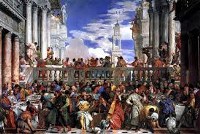
Veronese The marriage feast at Cana
When Veronese had painted the portraits of his beau monde in the The marriage feast at Cana, when he had devoted to it all the richness of his palette in sombre violets, in magnificent golden tones — then — there was still a faint azure and a pearly white he thought of — which doesn’t appear in the foreground. He flung it on at the back — and it was right, changed of its own accord into the surroundings of marble palaces and sky that singularly complete the array of figures.
That background is so magnificent in that it came about of its own accord, spontaneously, from a colour calculation.
Am I wrong about this?
Isn’t it painted differently from how someone would do it who had thought about the palace and about the figures at the same time? As a single whole?
All that architecture and sky is conventional and subordinate to the figures, calculated to make the figures show up well.
That is truly painting — and the result is more beautiful than precise imitation of the things themselves. Thinking about one thing and letting the surroundings belong to it, derive from it.
Making studies from nature, wrestling with reality — I don’t want to argue it away. I’ve tackled it that way myself for years and years, almost fruitlessly and with all sorts of sad results. I wouldn’t want to have missed that — error.
Always carrying on in the same way would be folly and stupid, that’s what I mean — but not that all my effort has been utterly in vain.
One begins by killing, one ends by healing is a doctors’ saying.
One begins by fruitlessly working oneself to death to follow nature, and everything is contrary.
One ends by quietly creating from one’s palette, and nature is in accord with it, follows from it. But these two opposites don’t exist without each other. Swotting, even if it’s apparently in vain, gives a familiarity with nature, a sounder knowledge of things. And a fine saying of Doré’s, who’s sometimes so clever! is I remember.
Although I believe that the finest paintings are made relatively freely from the imagination, I can’t break with the idea that one can’t study nature, swot even, too much.
The greatest, most powerful imaginations have also made things directly from reality that leave one dumbfounded.
In reply to your description of the study by Manet, I’m sending you a still life of an open, hence an off-white Bible, bound in leather, against a black background with a yellow-brown foreground, with an additional note of lemon yellow.
I painted this in one go, in a single day. This to show you that when I say that perhaps I haven’t swotted entirely for nothing I mean it, because these days it really comes quite readily to me to paint a given object, whatever the shape or colour may be, without hesitation.
Lately I made several studies outdoors, of the autumn landscape. I’ll send you the still life and one of these autumn studies soon. I’ll write again in the next few days anyway, and send this letter in haste to say that I was very pleased with what you say about black. Regards.
Yours truly,
Vincent
NOVEMBER
To Theo van Gogh. Nuenen, Tuesday, 3 or Wednesday, 4 November 1885.
My dear Theo,
I just received your letter and the enclosed, for which many thanks. Wanted to reply to you straightaway that I repeatedly came across sayings by Diderot, and also think that he’s perfectly in tune with his age.
With him it’s as it is with Voltaire himself; if one reads a letter from these fellows, preferably about the most prosaic things or about nothing, there’s an alertness and a sparkling spirit in them that charm. Let’s not forget that they made the Revolution, and it took genius to carry their age along with them and to get minds that are epicene and passive to strive in one direction towards a goal. So I have every respect for them.1
You’ll shortly receive two studies of the autumn leaves, one in yellow (poplars) — and the other in orange (oaks). I’m utterly preoccupied with the laws of colour. If only we’d been taught them in our youth!
But most people’s story, through a sort of fate, is to have to seek the light for a long time. For it’s absolutely certain that the laws of colour, which Delacroix first ordered and put forward in full and in context to the general benefit — as Newton did gravity and as Stephenson did steam — that these laws of colour are a light.
I’ve also made another autumn study of the pond in the garden at home. There’s definitely a painting in that spot. I did already try to get it out once last year.
The one I’ve made now is something of a stiff composition; two trees (orange and yellow) on the right, two bushes (grey-green) in the middle, two trees (brownish yellow) on the left. In front — the pond, black — foreground of withered grass. Background, a glimpse over the hedge onto a very bright green. A sky to harmonize with this in terms of power, in slate-grey and dark blue. They’ll certainly think it too black and too dark, but the time when one makes dark studies is always too short.”
To Theo van Gogh. Nuenen, on or about Saturday, 7 November 1885.
My dear Theo,
(…)
At the same time, to bring this off one has to be able to do a little magic, which costs one dear to learn, and Michelangelo’s gloomy, sarcastic words — my manner is destined to make great fools — is also true of those who dare take risks in regard to colour — there, too, it can’t be imitated by the cowards and the dependent.
I believe I’m making progress with the work.
Yesterday evening something happened to me that I’ll tell you as precisely as I can. You know the 3 pollard oaks at the end of the garden at home — I slogged away at them for the 4th time. I’d sat in front of them for three days with a canvas the size of that cottage, say, and the peasant cemetery you have.
The thing was the canopies of Havana-coloured leaves — how to model them and get the form, the colour, the tone. Then one evening I took it with me to that acquaintance of mine in Eindhoven, who has quite an elegant drawing room (grey wallpaper — furniture black with gold), where we hung it.
Well now, never before have I felt such a conviction that I’ll make things that work, that I’ll succeed in calculating my colours such that I have it in my power to create an effect. That was Havana, soft green and white-grey — even pure white straight from the tube. (You see that for my part, even though I talk about dark, I have no prejudice against the other extreme, the utmost extreme even.)
Although the man has money, although he really liked it — I had such a tingle of good spirits when I saw that it worked, that it created a mood as it hung there because of the soft, melancholy peace of that colour combination — that I COULD not sell.
But because it had affected him, I gave it to him, and he accepted it just as I meant it, without many words, that’s to say little other than — ‘the thing’s damned good’.
I don’t yet think so myself — I must first see some more Chardin, Rembrandt, Old Dutch and French fellows and really think things over — because I want to work even more vigorously with rather less paint than I used in this thing, for instance.
Now as to my acquaintance and his opinion of paintings — if someone with a clear, rational mind paints still lifes and works outside day in and day out, even if it’s only for a year, then he may not be an art expert as a result, then he doesn’t yet feel himself to be painter — but — nonetheless sees more coolly than many another. And then there’s also this about him, that his character is not like just anyone’s. For instance, he was originally supposed to have become a clergyman — at a certain moment flatly refused — and — got his way in that, which by no means everyone in Brabant succeeds in doing. And has something generous and loyal about him. This is something Zola once referred to — when in a conversation between Mouret and his school friend, he makes Mouret get serious and say that it has taken him a great deal of effort to overcome that time and its influence in himself, but that he wanted to live and that he was living. Many who endeavour to change slip back, don’t get any further than a certain colourless Methodism because they don’t take any measures vigorously enough. But that’s not the case with him; he is a man in his bourgeois world.
(…)
Nowadays — I like nothing better than working with a brush — drawing with it too — instead of making a design in charcoal. When I ask myself how the old Dutchmen set about it, I come up against the relatively few actual drawings. And how astoundingly they — draw. But — I believe that in most cases they began, they progressed, they ended — with their brush.
They — didn’t fill in.

Van Goyen An oak tree on a dune
A Van Goyen — for instance — I’ve just seen the one of his in the Dupper Collection, an oak tree on a dune in a storm, and the Cuyp, view of Dordrecht. An astounding technique — but — with nothing and as if of its own accord and beyond the paint and — apparently perfectly simple. But — be it in the figure — be it in landscape — how painters have always striven to convince people that a painting is something other than nature in a mirror, something other than imitation, that’s to say re-creation.
I would like to tell you a lot more about what Chardin, in particular, makes me think about colour — and — not making things the local colour. I think it’s splendid: ‘How to surprise — how to define the substance of this toothless mouth with its infinite subtleties. It’s made with nothing more than a few streaks of yellow and a few sweeping strokes of blue!!!’ When I read this, I thought of – Vermeer of Delft. When one sees it from close to, the townscape in The Hague is incredible, and done with completely different colours from what one would suppose a few steps away.
Regards, I really wanted to tell you right away how good I think De Goncourt’s book.
Yours truly,
Vincent
To Theo van Gogh. Nuenen, on or about Tuesday, 17 November 1885.
My dear Theo,
(…)
Wanted to let you know straightaway. It’s reassuring for me, too.
I’m really looking forward to Antwerp now. The first thing I’ll do there will probably be to go and see Leys’s paintings in his dining room, if one can see them. You know, that Walk on the ramparts and the one that Bracquemond etched, The table, The servant.
I imagine that it’ll be beautiful there in the winter, too, with snow on the docks. Obviously I’ll take a few paintings with me, and they’ll be the ones that I would otherwise have sent to you in the next few days.
A large mill on the heath in the evening, and a view of the village behind a row of poplars with yellow leaves, a still life and a number of drawings of figures.
I’m at something of a stand with the work here at present. It’s freezing hard, so it’s no longer possible to work outdoors. It’s better if I just don’t use any more models as long as I’m living in this house; at any rate not until I come back. Besides, I’m saving my paint and canvas so as to have ammunition there.
SO THE SOONER I CAN GET AWAY, THE BETTER.
I recently received a letter from Leurs about my paintings. He wrote that Tersteeg and Wisselingh had seen them and thought them ‘not suitable for them’.
All the same, I maintain that I’ll make people change their minds — even if Tersteeg and Wisselingh don’t want to.
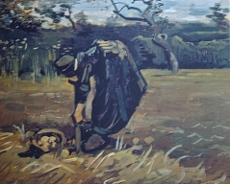
Peasant Woman digging up potatoes
I’ve just read a few books in the style of Gigoux’s Souvenirs, which my friend in Eindhoven had sent for, in which I found some very interesting things about the fellows of those days, starting with Paul Huet. And which give me confidence that I haven’t tackled nature the wrong way, nor the technique of painting, although I freely admit that I will and must still change.
There you have those heads that are with you, there must be good ones among them, I’m as good as certain of it. So — let’s go.
I don’t think this winter will be dull. It’s obvious that it’ll mainly be a question of working hard. But there’s something singular in the very idea that one has to take the plunge.
I’m taking a stock of the paint that I can easily get ground here myself — but it’ll help me if I can find a few more colours in a better quality there. I’m also taking at least 40 stretching frames the same size as those studies of heads that are with you. And drawing materials and paper so that, however I get on, I’ll always be able to do something.
Because I’ve worked entirely alone for years, I imagine that although I will and although I can learn from others and even adopt technical things — all the same I’ll always see through my own eyes and tackle things originally.
However, nothing could be surer than that I’ll try to learn more things. And if I can — particularly the nude figure. I imagine, though, that in order to get models, as many as I want and good, I won’t be done all at once, but will have to find the money for it by making other things. Be it landscapes, be it townscapes, be it portraits, as I said — or — even if it were signboards and decoration. Or — something I didn’t mention in my last letter among the things that I could do ‘on the side’ — give lessons in painting, letting them begin by painting still lifes — which I believe is a different method from that of the drawing masters. I’ve tried it out on those friends of mine in Eindhoven, and I’d dare repeat it.
(…)
Since I’m already busy packing up my things, it goes without saying that my thoughts are more there than here.
Here I’ve just kept on ceaselessly painting in order to learn painting, to get firm ideas about colour &c., without leaving much room in my head for other things. But when I escaped to Amsterdam for a few days, I was really delighted to see paintings once again. For it’s sometimes damned hard to be entirely away from paintings and the world of painters and not to see anything by other people. Since then I’ve had quite a yearning to get back into it, at least for a while.
If one’s entirely out of it for a couple of years and wrestles with nature, that can sometimes help, and at the same time one perhaps gets a new stock of confidence and health out of it, which one can under no circumstances have too much of, though, because the painter’s life is often harsh enough.
As regards my work, I’ll have to act according to circumstances, I mean, if I could perhaps make the acquaintance of an art buyer and persuade him to show some of my things. But tomorrow doesn’t mean never, and you’ll soon see something of it, particularly if I succeed in making new studies of heads or figures. The one landscape I’m taking with me — and possibly both — but the one with the yellow leaves: I think you’d like it too. I enclose a quick croquis of it.
The horizon is a dark line against a light line of sky in white and blue. In this dark line little flecks of red, bluish and green or brown, forming the silhouette of the roofs and orchards, the field greenish. The sky higher up, grey, against it the black trunks and yellow leaves. Foreground completely covered with fallen yellow leaves, in which 2 little black figures and one blue. On the right a birch trunk, white and black, and a green trunk with red-brown leaves.
Regards, with a handshake.
Yours truly,
Vincent
To Theo van Gogh. Nuenen, on or about Friday, 20 November 1885.
My dear Theo,
Many thanks for the 50-franc note and your letter. You’ll understand why I’m leaving next Tuesday when you realize firstly that I’m really longing to go — secondly that I’m in danger of becoming stuck with my work here for want of models, while working outdoors has stopped because of the cold.
As regards my certainly feeling the lack of a studio in Antwerp, yes, that’s so. But I have to choose between a studio without work here, and work without a studio there. I took the latter. And with pleasure that’s actually so great that it feels to me like a return from exile. After all, I’ve been out of the world of painting altogether for a long time. And in the meantime my powers have matured somewhat, so that I feel more independent of the usual intrigues to chuck someone out. I mean that in The Hague I was weaker than the rest with a brush, I don’t say in my drawing, and by attacking me on the painting and colour, I was more easily confounded than will prove possible now.
As for Rubens, I’m very much looking forward to him, but — don’t you often find that in terms of conception, in terms of the sentiment in his religious subjects, Rubens is theatrical, even badly theatrical? Look here — take Rembrandt — Michelangelo — take Michelangelo’s Pensieroso.
Meant to be a thinker, isn’t he? But — his feet are small and swift, but — his hand has something of the lightning speed of a lion’s paw, and — that thinker is at the same time a man of action, one sees that his thinking is concentration, but — in order to leap up and to act in one way or another. Rembrandt does it differently, his Christ in the Pilgrims at Emmaus is above all a — soul in a body that is anyway not the same as a torso by Michelangelo, but yet — the gesture of persuasion, there’s something powerful in it that — well, just put a Rubens next to it, one of the many figures of meditative people — and they become folk who’ve retired into a corner for the purposes of aiding their digestion.
It’s this brusqueness of touch that gives so much effect. The spontaneity of his impression is there in full, and communicates itself to the viewer.
(…)
I found the enclosed sonnet by Jules Breton in a Revue.
Regards.
Yours truly,
Vincent
Ruins
Old men, when near them, week by week,
Time has ravaged fruits and flowers in turn,
Old men, like Roman cities, have in their hearts
A forum – dead, with ruined temples strewn.
A silent waste through which their souls
Parade at length their barren tedium; where box and nettle
And the solitary grass, across the ancient site
Have choked the glory of its clamorous pomp.
Where words effaced from speechless pediments
Conceal their sense beneath the rusty stain of years.
No more songs now – the birds love blossom-time.
No rainbow prisms colouring the mists,
But sober suns, immense horizons,
Lighting the beauty at the ruins’ back.
Jules Breton
Nuenen [by Anton Kerssemakers]
It was some years after his stay in the Borinage – when, after having worked in The Hague and in Drenthe, he had come to stay in Nuenen, about the year 1884 that I made the painter’s acquaintance.
At the time I was engaged in painting a number of landscapes on the walls of my office, instead of having them covered with wallpaper, and in his peculiar way my house painter, who furnished me with colours, thought this so nice that one day he brought Van Gogh along to show him my work.
Van Gogh was of the opinion that I could draw, and kind-heartedly, as was his way, he at once showed himself willing to help me on with my painting. The consequence was our more intimate acquaintanceship and, on his friendly invitation, my visit to his studio at Nuenen, to which 1 shall revert later on.
My house painter had quite a lot of confidence in Van Gogh, and prepared for him the colours he most needed, such as the whites and the ochres and some others.
Seeing that the house painter was no expert at this job, these colours often left much to be desired in the matter of consistency, but Van Gogh had to content himself with them because of a lack of money.
I still have a little study as a souvenir of this unmanageable paint.
He painted it in a great hurry at my house, to instruct me; it was a view from my window in winter with melting snow, and the thin white colour ran all over the landscape.
On the occasion of my first visit to his studio at Nuenen it was impossible for me to get the right insight into his work; it was so totally different from what I had imagined it would be up to then, so rough and unkempt, so harsh and unfinished, that with the best will in the world I was unable to think it good or beautiful; and, badly disappointed, I decided not to go and see him again, and go my own way.
However, shortly afterward I discovered that his work had made a certain impression on me after all, which it was impossible for me to dismiss from my mind; every now and then his studies rose up before my mind’s eye again, so that I resolved to pay him another visit; it was as if I were drawn to it.
At my second visit the impression I got was considerably better, although in my ignorance I still thought that either he could not draw or that he carelessly neglected to draw his figures, and so on, and I took the liberty of telling him so straight out.
He was not at all cross at this, he only laughed a little and said quietly, Later on you will think differently. When I went away, he gave me some engravings from The Graphic and some by Adolf Menzel and others to take with me, saying that he advised me to look them over carefully and unhurriedly at home, and study them and draw copies of them. “You will learn a thing or two from this.”
On another occasion I took along a number of small studies that I had painted in the meantime, so as to hear what he would have to say about them.
Probably in order not to discourage me he said:
“Well, after all there is some good in it. But now I advise you to try and make a few still lifes first instead of landscapes; you will learn a lot from that. After you have painted some fifty of them, you will see how much progress you have made. And I am willing to help you and to paint the same subjects along with you, for I myself still have a good deal to learn, and there is nothing to equal this for learning to put things in their right positions, and for learning to get them properly separated in space.”
In this way, for days and even weeks on end, he tried to help me on with the utmost patience, in the meantime working on hard himself, doing innumerable drawings and watercolour sketches and studies in oil, indoors and out.
Once, when I had pretty well lost courage, and said to him, “Oh, I don’t think anything can be done with me I am too old to turn myself into a painter,” he mentioned a number of painters who had started late in life, and had become great masters for all that, including H. W. Mesdag.
Once, when we sat together in my studio painting the same still life, nothing more than a pair of wooden shoes and some pots taken at random, and I sat daubing away at it in my own manner, laying on the colour and scratching it off again without being able to get any relief into it, he suddenly walked over to me: “Look here, now you put – no, you needn’t be afraid I’ll spoil your drawing – a vigorous dark transparent touch there and there” – and at the same time he was already assailing my tiny canvas with his big broad brush. “Do you see? Like that. Look, now the other part comes to the front. It is wrong to go brushing away on the same spot, you must set it all down at once and then leave it alone; don’t be afraid, and don’t try to make it pretty.
“We’ll say we’ve done enough here for today, and now we must go and paint in the open air for a change; I’ll come here, if you like, or else you might come to Nuenen again; I know enough nice interesting spots there.”
So it came about that we made various painting excursions in the Nuenen district, as for instance to that little old medieval chapel that stood in the middle of a cornfield, and to the beautiful old windmill in the vicinity of Lieshout, of which I later saw in his house such a dashing, vigorous study with those small square sheep low down along the mill.
In those days he was starving like a true Bohemian, and more than once it happened that he did not see meat (for the purpose of eating) for six weeks on end, always just dry bread with a chunk of cheese. It won’t go bad on the road, he would say. The following story may serve as proof that he was quite accustomed to this and would not have it otherwise. Once in Nuenen, when we were about to set out on a ramble – it was in the afternoon at the height of summer – I said, “To begin with we’ll have a pot of coffee made in that inn over there, and eat a lot of bread and butter with trimmings, then we shall be able to keep going until late this evening.”
No sooner said than done, for he invariably consented to whatever you proposed.
The table was well furnished with various kinds of bread, cheese, sliced ham and so on.
When I looked, I saw he was eating dry bread and cheese, and I said, “Come on, Vincent, do take some ham, and butter your bread, and put some sugar in your coffee; after all, it has to be paid for whether you eat it or not.”
“No,” he said, “that would be coddling myself too much: bread and cheese is what I am used to,” and he calmly went on eating.
On the other hand he liked to have some brandy in his flask on his rambles, and he would not have liked to do without it; but as far as I know this was the only luxury he permitted himself. His studio too – he had rented a couple of rooms in the sexton’s house – had quite a Bohemian look.
One was amazed at the way all the available hanging or standing room was filled with paintings, drawings in watercolour and in crayon, heads of men and women whose clownish turned-up noses, protruding cheekbones and large ears were strongly accentuated, the rough paws calloused and furrowed, weavers and weaving looms, women spooling yarn, potato planters, women weeding, innumerable still lifes, certainly as many as ten studies in oils of the little old chapel at Nuenen that I mentioned, which he was so enthusiastic about that he had painted it in all seasons and in all weathers. (Later this little chapel was pulled down by the Nuenen vandals, as he called them.)
A great heap of ashes around the stove, which had never known a brush or stove polish, a small number of chairs with frayed cane bottoms, a cupboard with at least thirty different bird’s nests, all kinds of mosses and plants brought along from the moor, some stuffed birds, a spool, a spinning wheel, a complete set of farm tools, old caps and hats, coarse bonnets and hoods, wooden shoes, etc., etc.
Paintbox and palette he had had made in Nuenen according to his directions, as well as a perspective frame; this consisted of an iron bar with a long sharp point, on which he could mount, by means of screws, an empty frame like a small window. He said, The painters of old used a perspective frame at times, so why shouldn’t we?
Some time later I visited a number of museums in his company, the National Museum at Amsterdam being the first.
As I was unable to spend the night away from home for domestic reasons, he went the day before and made an appointment to meet me the next day in the third-class waiting room of the Central Station at Amsterdam.
When I came into this waiting room I saw quite a crowd of people of all sorts, railway guards, workmen, travellers, and so on and so forth, gathered near the front windows of the waiting room, and there he was sitting, surrounded by this mob, in all tranquillity, dressed in his shaggy ulster and his inevitable fur cap, industriously making a few little city views (he had taken a small tin paintbox with him) without paying the slightest attention to the loud disrespectful observations and critical remarks of the esteemed (?) public. As soon as he caught sight of me, he packed up his things quite calmly, and we started for the museum. Seeing that the rain was coming down in torrents, and Van Gogh in his fur cap and shaggy ulster soon looked like a drowned tomcat, I took a cab, at which he grumbled considerably, saying, “What do I care about the opinion of all Amsterdam, I prefer walking; well, never mind, have it your own way.”
In the museum he knew where to find what interested him most; he took me chiefly to the Van Goyens, the Bols and the Rembrandts; he spent the longest time in front of the “Jewish Bride”; I could not tear him away from the spot; he went and sat down there at his ease, while I myself went on to look at some other things. “You will find me here when you come back,” he told me.
When I came back after a pretty long while and asked him whether we should not get a move on, he gave me a surprised look and said, “Would you believe it – and 1 honestly mean what I say – I should be happy to give ten years of my life if I could go on sitting here in front of this picture for a fortnight, with only a crust of dry bread for food?” At last be got up. “Well, never mind,” he said, “we can’t stay here forever, can we?”
After that we went to Van Gogh’s Fine Art Establishment, where at his recommendation I bought two books, Musées de Hollande and Trésors d’art en Angleterre by W. Burger (Thoré); when I asked him if he would go inside with me, he replied, “No, I must not be seen on the premises of such a genteel, rich family.” He still seemed to be on bad terms with his family; he remained standing in the street, waiting for me.
Some time later we visited the museums at Antwerp, and I still remember one characteristic incident vividly. It was when he caught sight of the fisherboy carrying a basket on his back (I think it is by Velàsquez). Suddenly he disappeared from my side, and I saw him run to the picture; and of course I ran after him. When I reached him, he was standing in front of the picture with folded hands as if in devout prayer, and muttered, “God…damn it, do you see that?” After a while he said, “That is what I call painting, look” – and, following with his thumb the direction of the broad brush strokes – “he was one to leave what he had once put down alone,” and indicating the gallery with a wide, all-embracing gesture: “All the rest belongs to the periwig-and-pigtail period.”
He felt a deep veneration for Corot, Daubigny, Diaz, Millet, and further the whole Barbizon school, he was always full of it, and in his disquisitions on his beloved art he invariably reverted to them.
However, he never spoke about art with totally uninitiated persons, and he was terribly annoyed when a so-called picture lover from his entourage told him that he thought a thing of his was beautiful; then he knew for certain, he was in the habit of saying, that it was bad, and as a rule such studies were destroyed or repainted. Only with a few chosen friends, to whom I also had the good fortune of belonging – although in those days these friends were also unable fully to agree with his manner of painting – did he like to talk about painting, drawing, etching and so on, and many a time I have reproached myself for not having understood him better at the time, for if I had, how much more might I have learned from him.
He was always drawing comparisons between the art of painting and music, and in order to get an even better understanding of the values and the various nuances of the tones, he started taking piano lessons with an old music teacher who was at the same time an organist in Eindhoven. This, however, did not last long, for seeing that during the lessons Van Gogh was continually comparing the notes of the piano with Prussian blue and dark green and dark ochre, and so on, all the way to bright cadmium-yellow, the good man thought that he had to do with a madman, in consequence of which he became so afraid of him that he discontinued the lessons.
I was also present at the painting of the water mill at Gestel, which picture I later saw again at Oldenzeel’s and in the Boymans Museum at Rotterdam.
At the time he thought he had found a means of preventing the, to him, so hateful, sinking in of the colours by using copaiba balsam, but seeing that he was rather lavish in the use of this ingredient, as he was of his colours too, he used too much of it, and the result was that the whole sky of the picture came floating down, so that he had to remove it with his palette knife, as may still be seen in the picture on close examination.
Only a few pieces were signed by him. When I once asked him why he did not sign his name in full, he replied: “Van Gogh is such an impossible name for many foreigners to pronounce; if it should happen that my pictures found their way to France or England, then the name would certainly be murdered, whereas the whole world can pronounce the name Vincent correctly.”
He came to my house in Eindhoven very often. Once when I was sitting painting in my garden, I suddenly heard behind me: “Look here, yes, you are right to paint in the open air; you should do it often…Yes, do you see the slant of that roof? It must be an angle of at least forty-five degrees; it’s far too steep like that. And then I don’t know how you are going to handle your colours, but all this is of no importance, just go ahead. There is nothing from which one learns so much as from painting in the open air. In particular you should compare the objects with each other, especially for the tone. Painting is like algebra: something is to this as that is to the other. And above all, study your perspective carefully; if you start by making things green in the background, how can you expect to get them green in the foreground?”
Whenever he saw a beautiful evening sky, he went into ecstasies, if one may use the expression. Once, when we were tramping from Nuenen to Eindhoven toward evening, he suddenly stood stock-still before a glorious sunset, and using his two hands as if to screen it off a little, and with his eyes half closed, he exclaimed, “God bless me, how does that fellow – or God, or whatever name you give him – how does he do it? We ought to be able to do that too. My God, my God, how beautiful that is! What a pity we haven’t got a prepared palette ready, for it will be gone in a moment.
“Do let us sit down here for a minute. Take care you never forget to half-shut your eyes when you are painting in the open air. Once in a while those clodhoppers in Nuenen say that I am mad when they see me shuffling about over the moor, and stop, and crouch down in a half-sitting position, every now and then screwing my eyes half-shut, holding up my hands by my eyes, now in this way, now in that, in order to screen things off. But I don’t give a damn about that, I just go my own way.”
For weeks on end he would occupy himself exclusively with the drawing of hands, feet or wooden shoes. “That is something I must get a firm grip on,” he used to say.
One of the female models whom he used for painting studies of heads was his Dulcinea, according to village gossip. One repeatedly encounters her in his paintings of heads. It had even happened that this was objected to by one of the guardians of the villagers’ salvation, and moreover, he blamed the same person for his having been given notice to quit his studio. As he himself recounted, he had taken singular vengeance after that, something that we shall cover with the cloak of charity, as being less suitable to record here.
When he had finished his picture called “The Potato Eaters,” a picture done in very dark colours, with a hanging lamp over the table, around which a peasant family is sitting and eating steaming potatoes out of a dish, he carried it with him to Eindhoven to show me.
Afterward he made a lithograph of this picture at a label factory; he made twenty prints of this lithograph, some of which may still be in existence. Mine, however, became hopelessly tattered later on, as it was printed on ordinary, inferior paper.
Another time he came to me with the study of a woman spooling yarn; he had painted no spokes in the spooling wheel, but one continuous, unicoloured smear of transparent grey. This was such an extraordinary sight that I did not under stand it at first, and I asked him why he had done it in this way.
“Don’t you understand?” he asked me. “Once in a while the motion of the wheel is expressed this way.”
He always spoke of Anton Mauve with the highest respect, although in the past he had been unable to get along with him, and had worked in his studio for only a short time. According to what he told me, Mauve once made a disapproving remark because he touched his canvas too often with his fingers while painting; this caused him to lose his temper, and he snapped at Mauve, “What the hell does it matter, even if I did it with my heels, as long as it is good and has the right effect!”
For that matter this was a favorite expression of his; accordingly he used to say, Those little sheep have the right effect, or, That little birch tree might have a better effect, or, What a fine effect it has against that evening sky, and so on.
He had already mentioned more than once that he wanted to go away, but I had never paid much attention to it, as I did not think he meant what he said, but at last he came to me and announced his departure for Antwerp, and after that to France.
Before he set off he visited me once more to say good-by, and as a souvenir he brought me a beautiful autumn study, not yet entirely dry, finished completely in the open air, and measuring 3 ft. 4 in. by 2 ft. 8 in., and took away with him a little canvas as a souvenir in return.
This autumn picture is still in my possession; it is painted in a very light range of colours, and the subject is very simple; in the foreground three gnarled oaks, still full of leaves, and one poor bare beggar of a pollard birch, in the background a tangled wilderness of various trees and shrubs, partly bare, shutting off the horizon, and in the centre the little figure of a woman in a white cap, just dashed off in three strokes of the brush, but having a beautiful effect, as he would have said himself.
There is a striking atmosphere of autumn in this picture, it is painted in broad strokes, and the paint is richly laid on. When I remarked that he had not yet signed it, he said he might do so some time or other, “I suppose I shall come back someday, but actually it isn’t necessary; they will surely recognize my work later on, and write about me when I’m dead and gone. I shall take care of that, if I can keep alive for some little time.”
[Reprinted from the Amsterdam weekly De Groene (The Green One) of April 14 and 21, 1912.]
At this time, Vincent was 59 year old


